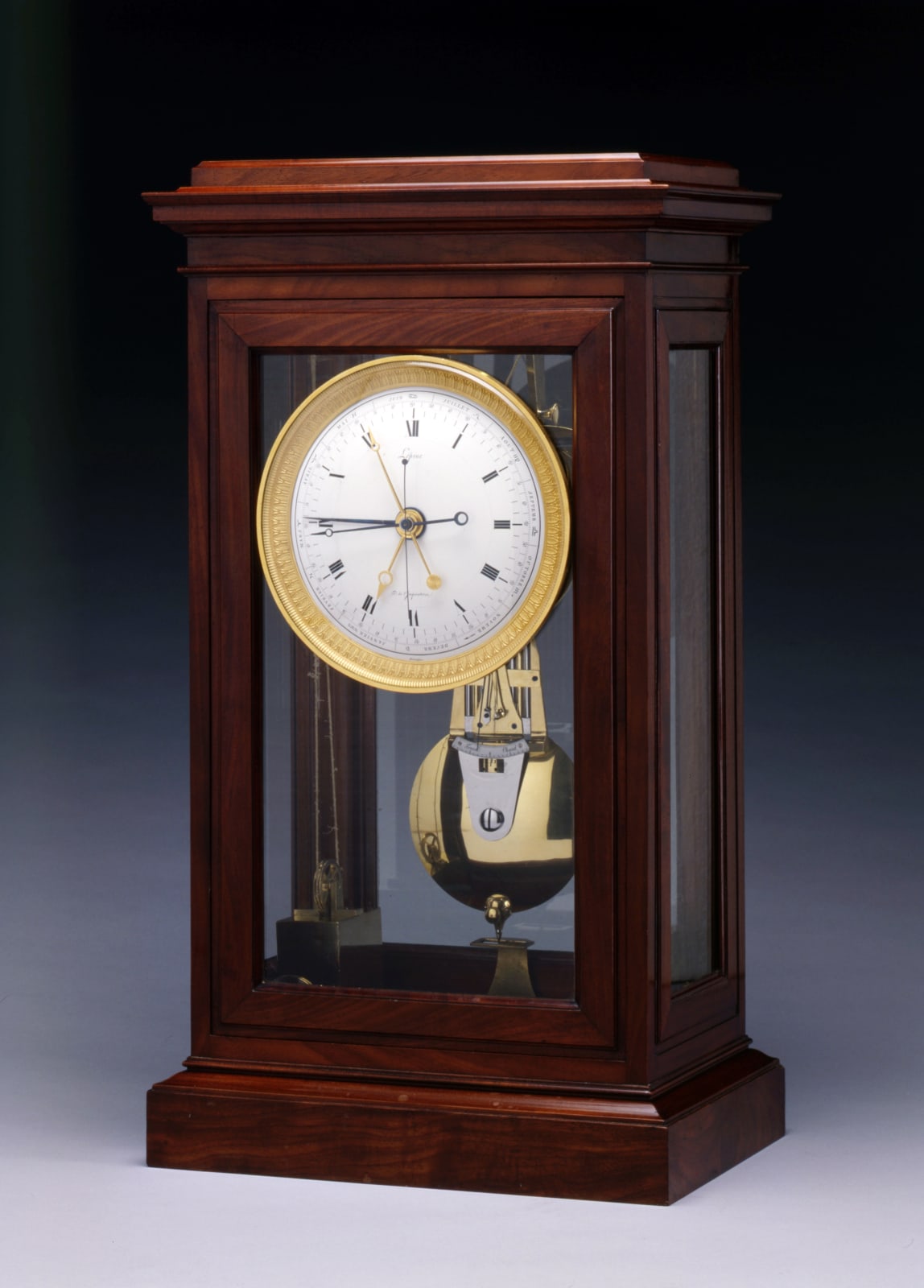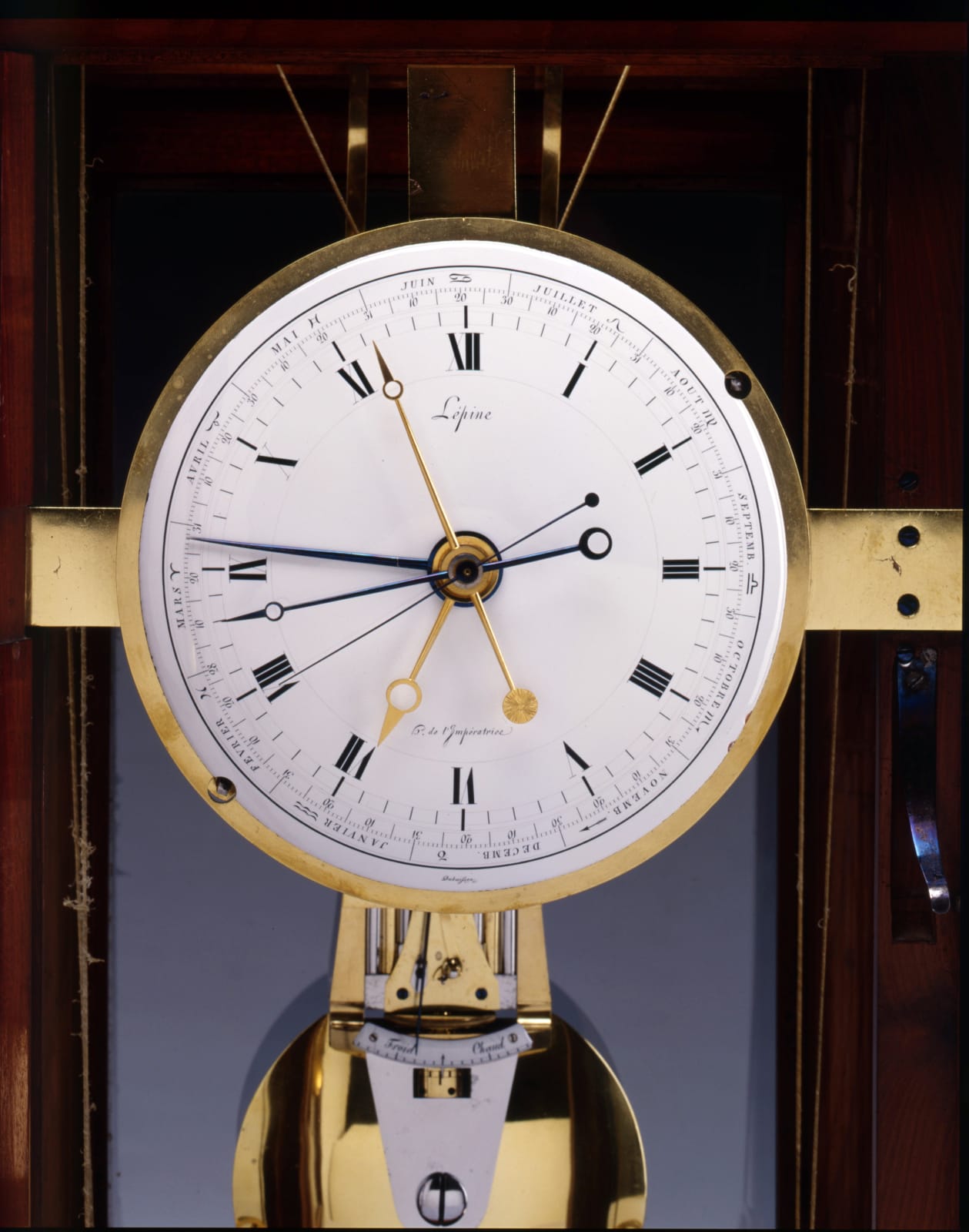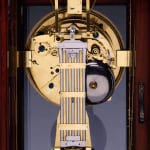Pierre-Claude Lépine (Raguet-) French, 1753-1810
Further images
Provenance
Julia Poiret, nee Bellanger, given to her by the widow Condu on 9th August 1893.
A magnificent Empire mahogany astronomical precision table regulator signed on the white enamel dial Lepine Hr de I'Tmperatriceand also signed below six o'clock by the esteemed dial painter, Dubuisson. The dial with outer names and signs of the months and numbers of days in each, with inner indications for the minutes and Roman numerals for the hours. The dial with five separate hands consisting of a pair of gilt brass hands for the minutes and hours, a very delicate blued steel hand for the sweep centre seconds and blued steel hands for the minute equation and year calendar indications. The massive movement with extremely rare original square weights for the going, with Graham anchor escapement, fully jewelled with maintaining power, knife edge suspension and a really superb nine-rod compensated pendulum, with spring driven strike, striking on the hour and half hour on a single bell with both winding holes hidden behind the gilt bronze bezel.
The rectangular mahogany case with glazed front, side and back panels, inscribed on a brass plaque attached to the base"SOUVENIR AFFECTUEUXAMA CHERE JULIA POIRET NEE BELLANGER Vve Condu 9AOUT1893
Paris, date circa 1805-1809
Height 61 cm, width 33 cm, depth 21 cm.
The remarkable career of Pierre-Claude Raguet, known as Lepine (1753-1810) coincided with the decline of Louis XVI, the Revolution and Napoleon's subsequent rise to power. Born in Dole, the son of a cloth merchant named Antoine Raguet, in 1782 Pierre-Claude married his first wife, Pauline, only daughter of the renowned horologist, Jean-Antoine I Lepine (1720-1814). Prior to his marriage Pierre-Claude had invested 16,000 livres in Lepine's business and then purchased a third share in 1783. Working actively with his father-in-law, in June 1784 he effectively took over the business under the name of' Lépine a Paris, Horloger du Roi'. Later - in 1793 he was appointed a member of the jury responsible for determining a new Revolutionary time system. His next major appointment came in 1805 as Horloger brevete de Sa Majeste1'Imperatrice-Reine, which was followed in 1809 to Imperatrice-Jose'phine. Lépine died the following year on 30th May at Villeneuve-le-Roy and just over a month later his son, Alexandre-Pierre-François sold the business to Jean-Paul Chapuy. Trading under its original name, the firm continued to prosper until 1916.
JEAN-ANTOINE LEPINE (1720-1814). FRENCH
Jean-Antoine Lepine combined perfect technical quality with aesthetic design. He was appointed clockmaker to Louis XV and Louis XVI, for whom he made 20 clocks. His firm also made clocks for Napoleon, one of which is in the Palais de Compiegne, while another for the Empress Josephine is in the Mobilier National, Paris. Lepine was also patronised by the Spanish and English royality, three Lepine mantle clocks and an astro clock are housed at Buckingham Palace, London. In addition, Lepine time pieces can be found in the Victora and Albert Museum and the Guildhall, London; the Fitzwilliam Museum, Cambride; the Carnegie Museum; the National Museum of Stockholm; Basel Museum; Mathematische Physikalische Salon, Dresden and Geneva Horological School.
The son of Jean Lepine, a mechanic who made music boxes for Louis XVI, Jean-Antoine was born in Gex, France. He served an apprenticeship under Decrose of Grand Sacconex, Switzerland. By 1744 Lepine was established in Paris, working for Andre Charles Caron (1697-1775).In 1756 he married Caron's daughter and was promptly made a partner. The firm of Caron et Lepine at Rue St.Denis continued until 1769, when Lepine succeeded the elder.During the 1770's he also acted as an agent for Voltaire's workshops at Ferney, near Geneva. In 1772 Lepine transferred his Parisian business to Place Dauphine, by 1778 he was operating from Quai de l’Horlogue and from 1781-87 at Rue aux Fosses. He was joined by his son in law, Claude Pierre Raguet (1753-1810), who took over the business, 1783. In 1810 the firm was sold to J. B. Chapuy, who among others employed Jacques Lepine (nephew of Jean-Antoine). The firm continued to prosper under various owner, trading under the name of its founder until 1916.
The development of watch and clock making is indebted to Lepine's technical innovations, his most notable, c. 1760 was the Lepine calibre which resulted in the production of the first genuinely thin watch. The Lepine calibre was soon accepted and developed by other French watchmakers, notably A. L. Breguet (1747-1823). However it was not adopted in England , so while the demand for "thin" watches increased, French watchmakers soon established a pre-eminence. The Lepine calibre is now a universal movement in all watches. Lepine continued to perfect the internal design of his "thin" watches so that parts were more accessible for repair and maintenance. These watches were highly prized, in 1781 he was selling them for £ 840 a piece. Lepine also introduced other innovations such as a watch that wound by a push-piece.
Lepine was also at the forefront of design, and with Breguet was one of the first to use Arabic numerals, for a period he used a combination of both Arabic and Roman figures, but by 1789 his firm had returned to Roman numeration. Lepine developed a unique decoration, surrounding the number 1 with a circle to create an aesthetic balance with the number 11; it appears that he was the only watch and clockmaker to do so The Lepine firm employed some of the finest craftsmen to create fashionable and decorative cases such as Nicolas Petit who created sumptous cases in the Louis XVI style. Thus while Lepine placed emphasis on design he and his firm also aspired toward mechanical excellence.
Copyright by Richard Redding, Zurich. All rights reserved!





